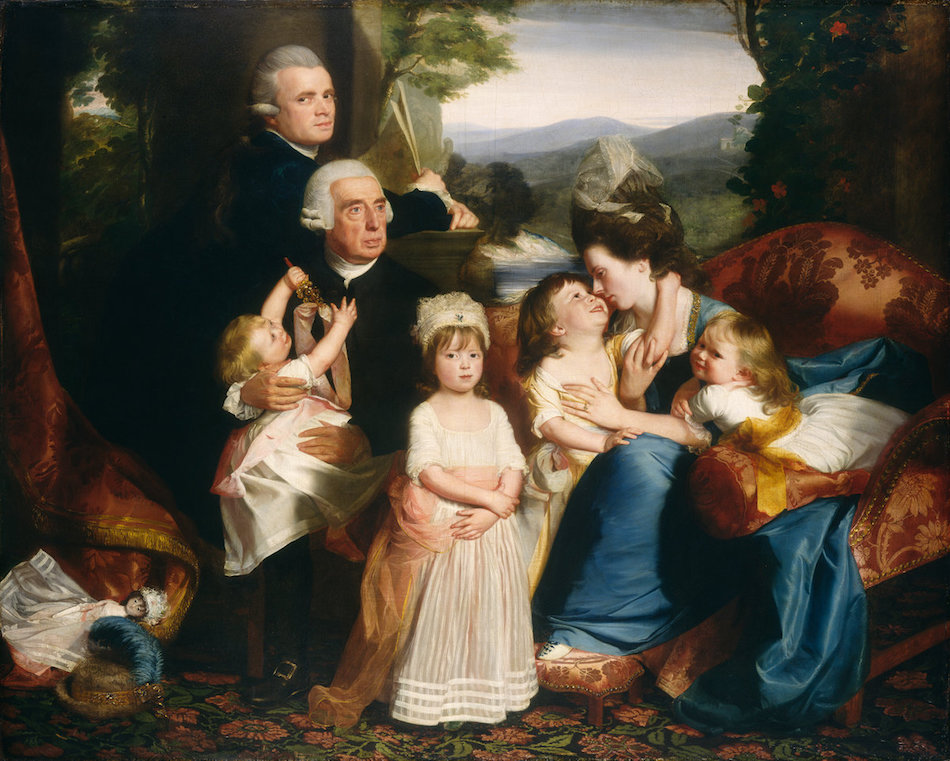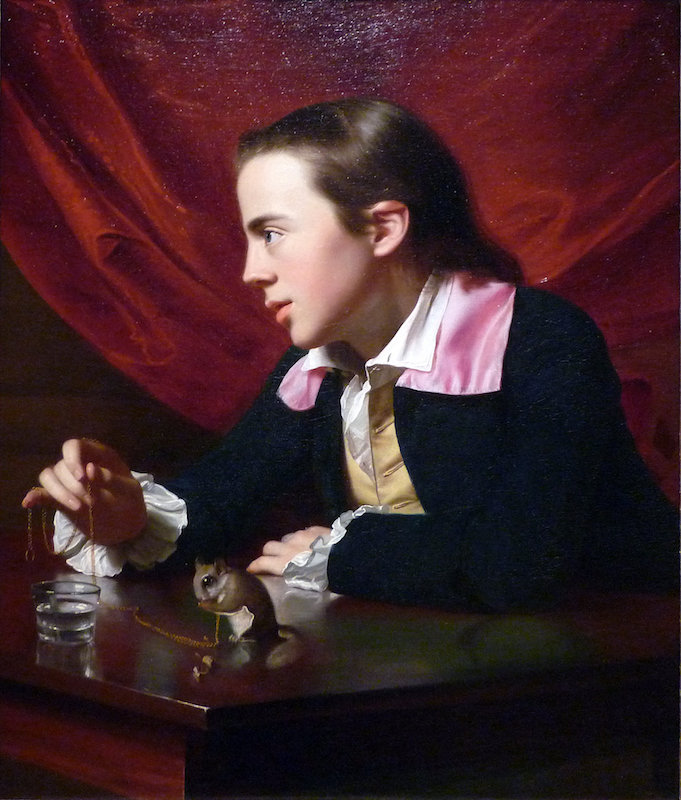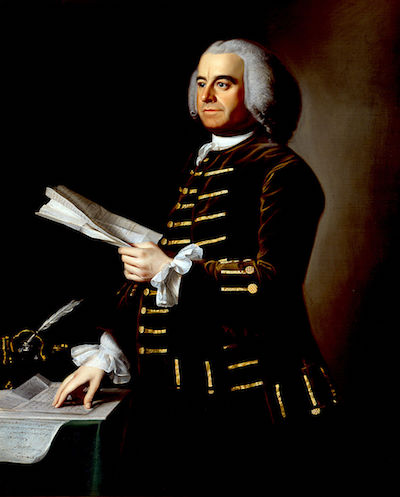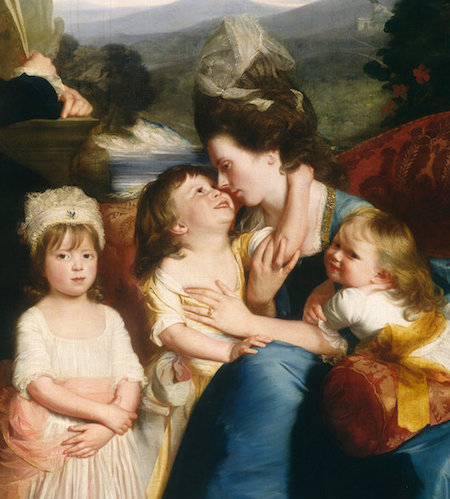
John Singleton Copley, The Copley Family, 1776–77, oil on canvas, 184.1 x 229.2 cm (National Gallery of Art)
Invitations to visit Europe
By the time the 1770s arrived, John Singleton Copley was the undisputed king of portraiture in the American colonies. Yet despite this fact, he had longed to visit the Old World, and he had, in fact, received much encouragement to permanently move to London. Copley’s early masterwork Boy with a Squirrel, a portrait of his half brother Henry Pelham, had been shown at the 1766 Society of Artists exhibition. Many artists, particularly Benjamin West and Sir Joshua Reynolds, had been suitably impressed with the artistic virtuosity of the New World wunderkind. West, himself a colonial, wrote to Copley on 4 August 1766 to encourage him embark on a Grand Tour of Europe. With his creative spelling, West urged Copley to make a “viset to Europe for this Porpase for three or four years, you would find yourself then in Possession of what will be highly valuable” (this and all quotes use the 18th century spelling).

John Singleton Copley, A Boy with a Flying Squirrel (Henry Pelham), 1765, 77.15 x 63.82 cm / 30-3/8 x 25-1/8 inches (Museum of Fine Arts, Boston)
Copley, ever the prudent businessman, was seldom rash or spontaneous. Although West provided rather constant motivation, Copley remained unconvinced that he would have a more affluent life in London than the one he then had in Boston. On 17 June 1768, for example, Copley wrote to the West that, “I should be glad to go to Europe, but cannot think of it without a very good prospect of doing as well there as I can here. You are sensable that 300 Guineas a Year, which is my present income, is a pretty living in America.” Copley continued in this letter to make it clear that he had family obligations to consider: “And what ever my ambition may be to excel in our noble Art, I cannot think of doing it at the expence of not only my own happyness, but that of a Tender Mother and a Young Brother whose dependance is intirely upon me.”
Several years later—in January 1772—John Trumbull, the future painter of the Declaration of Independence, was travelling from his home in Connecticut to Cambridge, Massachusetts in order to enroll at Harvard College. Although Trumbull wanted to be an artist, his father, the former governor of Connecticut, wished for his son to receive a college education and to pursue a more socially prestigious vocation. Although Trumbull was unenthusiastic about the prospect of being a college student, he was excited about visiting Copley, an encounter made possible through a mutual friend. Writing his autobiography nearly fifty years later, Trumbull still recalled this first brush—get it? Brush!—with artistic fame:
We found Mr. Copley dressed to receive a party of friends at dinner. I remember his dress and appearance—an elegant looking man, dressed in a fine maroon cloth, with gilt buttons—this was dazzling to my unpracticed eye! —but his paintings, the first I had ever seen deserving the name, riveted, absorbed my attention, and renewed all my desire to enter upon such a pursuit.
Copley leaves for London (as political tensions rise) and goes on the Grand Tour

John Singleton Copley, Portrait of Colonel George Watson, 1768, oil on canvas, 58 3/4 x 48 7/8 (New Orleans Museum of Art)
In a city—Boston—that was becoming increasingly more divided between the Tories and the Whigs (those who preferred loyalty to Britain and those who wished for independence, respectively), Copley remained as apolitical as he could. Indeed, a look at his Boston patronage indicates that he painted sitters on both sides of the growing vitriolic political divide.
But as the 1770s progressed, Copley’s life became more and more uncomfortable. Most of his wife’s family were strident Loyalists. His father-in-law Richard Clarke, for example, was the owner of the tea that provoked the Boston Tea Party on 16 December 1773. Several months later—April of 1774—an angry mob arrived at Copley’s home looking for Colonel George Watson, a Tory lawyer Copley had painted in 1768.
This unruly event frightened Copley and helped him realize that the political climate was beginning to get out of hand. “What a spirit!” Copley wrote on 26 April. “What if Mr. Watson had stayed (as I pressed him to) to spend the night. I must either have given up a friend to the insult of a Mob or had my house pulled down and perhaps my family murthered.” Fearful for his own safety, Copley sailed for London in June 1774, just seven weeks later. His family—wife, children, mother, and half-brothers—remained in Boston.
Copley’s passage across the Atlantic lasted until the second week of July, and he wasted little time in visiting Benjamin West, Joshua Reynolds, and the Royal Academy of Art. After some time in London, Copley began his continental Grand Tour, an eighteenth-century staple of art education for an aspiring painter. He first visited Paris—writing to his wife on 2 September—then made his way to Rome via Genoa. Copley arrived in Rome on 26 October and spent the next seven months viewing art and architecture and copying the Old Masters. He also made several side trips to Naples, Pompeii, Herculaneum, and Paestum.
A letter Copley wrote to his mother from Parma on 25 June 1775 states that he had finally left Rome for London on 4 June 1775; he had already visited Florence on his way north. Still in Parma on 22 August, Copley wrote a lengthy letter to his half-brother and stated that, “I propose going from this [Parma] to Venice and through the Tirole, Germany, and Flanders, which is the shortest way to England and a different Rout from that I took in coming to Italy. I shall not return to Parris as I intended.”
In just fifteen months—that is from his departure from Boston to his return to London from the continent in October 1775—Copley had received nothing short of an art education unavailable to anyone in North America. He was primed to open a painting studio in London. By the time he returned to London, his wife and three of their (then) four children were awaiting his return (the youngest, Clarke Copley, born in 1775, did not travel with the rest of the family and died the following year). Copley thusly flipped the page to a new chapter—the English Chapter—in his professional life.

Copley, John Singleton, The Copley Family, 1776-77, oil on canvas, 184.1 x 229.2 cm (National Gallery of Art)
The Copley Family
Copley painted an immense group portrait, The Copley Family, in order to celebrate—and announce—this new chapter in his professional development. This painting accomplished several independent goals at the same time. To begin, it serves as a kind of visual testament to his love and devotion to his family. During their nearly 15 months apart, Copley’s correspondence—primarily to his own mother, his half-brother Henry, and his wife Suzanna who he affectionately referred to as Sukey—is filled with references to both missing his family and his fear for their safety in the increasingly tenuous city of Boston. Writing from Lyon on 15-16 September 1774, for example, Copley stated, “I am very Ancious for you, my Dear, and our Children, for I know not what state you are in, in Boston; but I pray God to preserve you and them.” In closing, he sends affectionate tidings: “give my blessing to my Dear Babys, and a thousand Kisses. tell my Dear Betsey not to forget he[r] Papa.”
The Copley Family shows the six members of the artist’s clan as it existed at the beginning of 1777. Copley has shown three adults—the artist, his wife, and her father—and his four children. As was typical with group portraits that included a self-portrait—see Raphael in The School of Athens and Smibert’s self representation in The Bermuda Group, both of which Copley would have seen—the artist looks directly at the viewer, a look of inquisitiveness on his visage. He holds a set of drawings and leans on a classical plinth. His father-in-law, Richard Clarke, looks to the viewer’s right, seemingly unaware that the youngest daughter, Susanna, is attempting to climb onto his lap. Sukey, shown in profile, lovingly nuzzles John Singleton, Jr., their only son, while Mary, on the far right, attempts to capture her mother’s attention. The only other sitter who seems alerted to the viewer is the oldest, Elizabeth, who stands seemingly unaware of the happenings behind her.

Copley’s wife and three children (detail), John Singleton, The Copley Family, 1776-77, oil on canvas, 184.1 x 229.2 cm (National Gallery of Art)
Although Clarke seems more aloof than loving, the rest of the participants in this stage-like setting seem to express tenderness and love for one another. Children play and vie for motherly affection. Sukey plays the maternal role of a loving and tender parent. Elizabeth, the oldest, suspiciously stares at the viewer as if facing a stranger. Copley demonstrates—as he had so consistently in Boston—a keen ability to paint psychologically rich and complex compositions. These are not only accurate likenesses of those who he most loved. Indeed, Copley is able to tell us, through visual means, a bit about who they are.
However, this portrait was not only intended to accurately record who the Copley family was and what the Copley family looked like at a particular moment in time. Instead, Copley completed this work as a way of both advertising his talents and abilities as a painter, but also to announce his family’s formal arrival into fashionable London society. Copley and his wife wear clothing then at the height of fashion, and this attire, in addition to the drapery on the left of the painting and the extravagant furniture and beautifully rendered carpet, dually speaks to the artist’s affluent wealth and his ability at painting fabrics. The drawing he holds, the vase behind his hands—identified as a copy of the Medici Vase Copley would have seen in the Uffizi while in Florence—and the Italianate landscape in the distance that appears as if borrowed from a Raphael Madonna and Child painting all proclaim his Grand Tour pedigree.
Available for hire
In size (6’ x 7.5’), composition, and in artistic references, Copley intended for this group portrait to eloquently advertise that his newly arrived services were available for hire to the London portrait-seeking public. Copley exhibited this work at the 1777 Royal Academy show to nearly universal acclaim. In a career that would extend for almost another forty years, this painting is the only one he formally exhibited with his own likeness within it. Clearly, the work is not only about what it is, but also who made it. The artist achieved his goal. One critic remarked, “Mr. Copley, from the size of his family piece, is likely to be as much the subject of observation in the rooms as any artist who has exhibited…” Years later, in 1792, Copley had achieved such fame that he was set to rival his former advocate, Benjamin West, for the presidency of the Royal Academy of Art. Between The Copley Family in 1777 and the end of his career, the artist shifted his attention from portraiture—which had been his only focus in the American colonies—to that of the more prestigious and ambitious history paintings.

